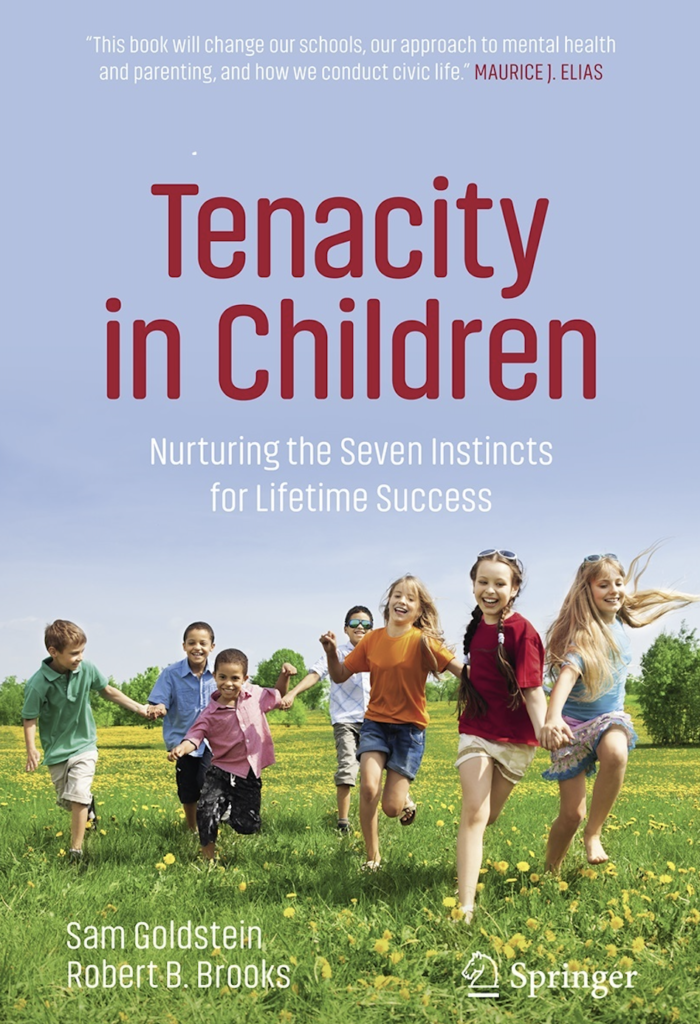Article date: April 19, 2021 Robert B. Brooks and Sam Goldstein
This month’s article, co-authored with my friend and colleague Dr. Sam Goldstein, describes tenacity, a concept we introduced in our most recent book Tenacity in Children: Nurturing the Seven Instincts for Lifetime Success.  The book represents a culmination of our almost 30-year collaboration and incorporates our earlier concepts of resilience and self-discipline to include tenacity as the third component of what we call the “essential triad of human development.†A brief explanation and history of the triad is in order.
In the first book we co-authored, Raising Resilient Children, we defined resilience as a process of competent functioning under duress and adversity. We identified the components of a “resilient mindset†and included self-discipline as one of these components. As we continued to elaborate our understanding of a resilient mindset and the behaviors associated with this mindset, we came to appreciate that self-discipline deserved separate and special attention. We perceived self-discipline to be the inner control required to focus and direct us as we engage in activities that reinforce resilience over time. The absence of inner control would make it increasingly challenging to become resilient. Appreciating the impactful role of self-discipline in development served as a catalyst for us to co-author Raising a Self-Disciplined Child in 2007, six years after the publication of Raising Resilient Children.
Since 2007 we have positioned the concepts of resilience and self-discipline at the center of our clinical work, consultations, and writings. However, as we continued to reflect upon our theoretical framework, we recognized that something was missing from our formulation, namely, a consideration of the self-determination necessary to fuel and maintain resilience and self-discipline. We labeled this self-determination tenacity and noted that it was represented by a sense of will, strong mindedness, and purpose.
In reviewing many studies and writings, we proposed that tenacity is composed of seven instincts which, as the word instinct implies, are present from birth. We believe that while there are other instincts, the seven we have identified have proven to be of the greatest significance in our development. They have evolved over thousands and thousands of years, ensuring the success and survival of our species. Most professionals and the lay public have moved beyond the assumption that children come into this world as tabula rasa or blank slates waiting to be infused with knowledge. Most are aware that children are different from birth in significant ways, including their inborn temperament.
However, while there has been a shift from a belief in tabula rasa, many may not be aware of the dynamic instincts that exist in each child from birth and the prominent role they play in the course of a child’s development. For example, the early, rudimentary manifestations of such attributes as optimism, motivation, empathy, and altruism to name just a few are present at birth, waiting to be nurtured and brought to fruition by parents and other caregivers. In light of the role that these instincts play throughout our lives, we believe that it is imperative for parents, educators, mental health and childcare professionals to strive to identify and reinforce them in children.
In our using the word “instinct†it’s important to distinguish the different expressions of instincts in some species compared with our own. In animals, instincts are manifested as fixed patterns of behavior that lead to a very specific outcome such as a bird building a nest for the first time or a salmon returning upriver to its birthplace. We contend that in our species instincts represent an intuitive, more flexible way of thinking and/or acting that increase the chances of survival and success.
The remainder of this brief article identifies the seven instincts of tenacity. In follow-up writings we will elaborate on these seven and, in addition, describe three other instincts that we have labeled the “unholy trinity.†They are: a rigid adherence to belief, a fear of difference, and defensive aggression to real or perceived threat. At one point in our evolution these three served to protect our survival, but now they represent negative forces that are at the root of many of our current problems. Reinforcing the seven instincts of tenacity will help to minimize the emergence or influence of the unholy trinity.
The following are the seven instincts of tenacity. As is evident, different instincts overlap with and reinforce each other. They do not stand alone but rather intertwine to create a very rich fabric.
Intuitive Optimism is the belief that gratifying and successful outcomes can be achieved despite existing challenges. Children retain the belief that with perseverance as well as assistance, when necessary, from parents, educators, and other caregivers they will ultimately experience success. Strategies to foster Intuitive Optimism include: reinforcing a sense of personal control from an early age, teaching problem-solving strategies, identifying strengths or what we call “islands of competence†to build confidence, and helping children view setbacks and mistakes as experiences from which to learn.
Intrinsic Motivation posits that children are motivated to engage in tasks when certain inner needs are being met without the presence of contingent rewards. These needs include: belonging and connecting with others, providing a feeling of security; self-determination and autonomy, reinforcing a belief that they are being heard, respected, and have input into situations impacting their lives; a sense of competency as the source of the ability of children to successfully perform, master tasks, and reach goals in their world; and a sense of purpose, often represented by children subscribing to a greater good.
Compassionate Empathy is composed of two main dimensions: empathy is the ability to understand the world of another person both on an affective and cognitive level, while compassion involves using that understanding to initiate actions that express caring towards others. This instinct serves our deepest needs to survive, to connect, and to find our partners in life. Using empathic communication with our children can secure important benefits, including our having enriched relationships with them and their learning to connect with others in more gratifying ways.
Simultaneous Intelligence is to comprehend how different pieces of information fit together into a whole as a basic skill in solving problems. Children become more effective critical thinkers and problem solvers when they create categories and classify items, identify relevant information, construct and recognize valid deductive arguments, recognize reasoning fallacies, and distinguish between evidence and interpretations of evidence. Parents and teachers can reinforce this instinct whenever children are navigating through problems by encouraging them to consider alternative explanations and solutions, discuss biases, ask open-ended questions, and encourage thinking in new ways.
Genuine Altruism is an unselfish concern for others, represented by acting to alleviate their distress with no expectation of reciprocation. Altruism is an instinct worthy of cultivation through socialization and modeling. Children benefit from helping others. These actions improve mood, behavior, and self-image, reinforce positive relationships, and promote a sense of purpose.
Virtuous Responsibility is the ethical and moral responsibility we have to enhance the lives of family, friends, and members of our society. This instinct extends beyond the scope of helping others, because it involves making decisions and engaging in behaviors that demonstrate that we can be trusted and accountable for our actions. Assuming responsibility is rooted in the ways in which parents and caregivers discipline children in order to nurture qualities of self-discipline and accountability.
Measured Fairness is an important foundation of morality and the evolution of cooperation in human beings. It is allied to pro-social behaviors such as effective communication, empathy, cooperation, problem-solving skills, and forgiveness as the basic underpinnings of connected, generous, and successful lives. This instinct is nurtured in children by helping them develop a sense of personal control. They learn to believe that while they may not always have control over challenging situations, they can have a choice over their attitude and response to these situations.


